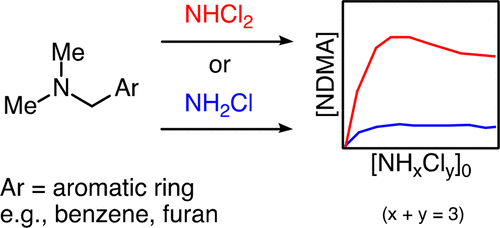当前位置:
X-MOL 学术
›
Environ. Sci. Technol. Lett.
›
论文详情
Our official English website, www.x-mol.net, welcomes your
feedback! (Note: you will need to create a separate account there.)
Re-Examining the Role of Dichloramine in High-Yield N-Nitrosodimethylamine Formation from N,N-Dimethyl-α-arylamines
Environmental Science & Technology Letters ( IF 8.9 ) Pub Date : 2018-01-26 00:00:00 , DOI: 10.1021/acs.estlett.7b00572 Meredith E. Huang 1 , Shiyang Huang 1 , Daniel L. McCurry 1
Environmental Science & Technology Letters ( IF 8.9 ) Pub Date : 2018-01-26 00:00:00 , DOI: 10.1021/acs.estlett.7b00572 Meredith E. Huang 1 , Shiyang Huang 1 , Daniel L. McCurry 1
Affiliation

|
N-Nitrosodimethylamine (NDMA) is a potent carcinogen associated with chloramination of wastewater and wastewater-impacted drinking waters. Substantial effort has been expended to identify the precursors and mechanisms leading to NDMA formation. One of the major discoveries has been that molecules in the N,N-dimethyl-α-arylamine class, including the common pharmaceutical ranitidine, form NDMA in high yield during chloramination. Simultaneously, it was hypothesized that these precursors react with monochloramine, the dominant species in most chloramine mixtures, to form NDMA. This monochloramine hypothesis contradicts past mechanistic work with simple secondary amines, as well as practical experience showing that minimization of dichloramine reduces the level of NDMA formation during wastewater reuse and drinking water treatment. In this work, we address the contradiction between practical experience and model precursor studies by showing that N,N-dimethyl-α-arylamines form NDMA chiefly via reactions with dichloramine, rather than monochloramine. We experimentally demonstrate substantially higher NDMA yields from dichloramination than from monochloramination of four N,N-dimethyl-α-arylamine compounds, including ranitidine, and computationally rationalize declining NDMA yields at large dichloramine doses, which may explain past results reporting low NDMA yields from dichloramination of ranitidine. These results provide support for NDMA control strategies currently under evaluation at wastewater reuse facilities.
中文翻译:

重新检查二氯胺在由N,N-二甲基-α-芳基胺形成的高产N-亚硝基二甲胺中的作用
N-亚硝基二甲胺(NDMA)是一种强力致癌物质,与废水和废水影响的饮用水中的氯化作用有关。已经花费大量努力来鉴定导致NDMA形成的前体和机理。主要发现之一是N,N中的分子-二甲基-α-芳基胺类(包括常用的雷尼替丁)在氯化反应中高收率地形成NDMA。同时,假设这些前体与大多数氯胺混合物中的主要物质一氯胺反应形成NDMA。一氯胺的假设与过去的机械工作与简单的仲胺相矛盾,实践经验表明,二氯胺的最小化可减少废水回用和饮用水处理过程中NDMA的形成水平。在这项工作中,我们通过证明N,N来解决实践经验与模型先驱研究之间的矛盾。-二甲基-α-芳基胺主要通过与二氯胺而不是一氯胺反应形成NDMA。我们实验证明了四氯联苯胺比四种N,N-二甲基-α-芳基胺化合物(包括雷尼替丁)的单氯胺化具有更高的NDMA产率,并且在大剂量的二氯胺剂量下通过计算合理化了NDMA产率的下降,这可能可以解释以往的结果,即报告说二氯胺化的NDMA产率较低雷尼替丁。这些结果为废水回用设施目前正在评估的NDMA控制策略提供了支持。
更新日期:2018-01-27
中文翻译:

重新检查二氯胺在由N,N-二甲基-α-芳基胺形成的高产N-亚硝基二甲胺中的作用
N-亚硝基二甲胺(NDMA)是一种强力致癌物质,与废水和废水影响的饮用水中的氯化作用有关。已经花费大量努力来鉴定导致NDMA形成的前体和机理。主要发现之一是N,N中的分子-二甲基-α-芳基胺类(包括常用的雷尼替丁)在氯化反应中高收率地形成NDMA。同时,假设这些前体与大多数氯胺混合物中的主要物质一氯胺反应形成NDMA。一氯胺的假设与过去的机械工作与简单的仲胺相矛盾,实践经验表明,二氯胺的最小化可减少废水回用和饮用水处理过程中NDMA的形成水平。在这项工作中,我们通过证明N,N来解决实践经验与模型先驱研究之间的矛盾。-二甲基-α-芳基胺主要通过与二氯胺而不是一氯胺反应形成NDMA。我们实验证明了四氯联苯胺比四种N,N-二甲基-α-芳基胺化合物(包括雷尼替丁)的单氯胺化具有更高的NDMA产率,并且在大剂量的二氯胺剂量下通过计算合理化了NDMA产率的下降,这可能可以解释以往的结果,即报告说二氯胺化的NDMA产率较低雷尼替丁。这些结果为废水回用设施目前正在评估的NDMA控制策略提供了支持。











































 京公网安备 11010802027423号
京公网安备 11010802027423号